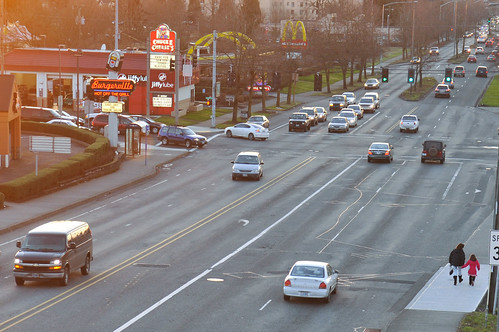
A man in a pickup truck allegedly forced a bicycle rider off the I-205 bike path in southeast Portland Saturday afternoon.

A man in a pickup truck allegedly forced a bicycle rider off the I-205 bike path in southeast Portland Saturday afternoon.
It’s good, but it should be great.
Nearly five years after it first opened, it’s time to implement a permanent design for the protected bikeway on Northeast Multnomah Street through the Lloyd District. Hopefully one that’s truly befitting of one of America’s best biking cities — not an overly comprised, on-the-cheap, paint-and-posts half-measure.
“The new service has potential but unfortunately misses the mark at nearly every step of the way.”
This past weekend, my family and I decided to try out ODOT’s new Columbia Gorge Express bus and spend a few hours at Multnomah Falls. After our experience, I unfortunately cannot personally recommend this service.
We decided to take the 12:55 pm bus from Gateway TC. Getting to Gateway car-free already meant a bus and a train from where we live. Unfortunately, our Columbia Gorge Express bus was 20 minutes late – not arriving until 1:15 and departing around 1:20. Tickets are purchased pre-paid but don’t actually guarantee you a spot on the bus. After a minor hassle with the ticket checker about the tickets being purchased for the wrong day (the website makes you pick a day, but specifies the ticket is in fact good for any day in the current season), we were aboard.
The bus first made a stop at Rooster Rock park to pick up and drop off passengers. There was not room for everyone, so many were left waiting for the next bus. After this ten minute stop, we were finally on our way to the falls. Upon coming up to the falls, our bus driver informed us that since the parking lot at Multnomah Falls was full, that we would not be able to exit the highway here, as there would be no room for the bus to turn around. We instead had to make a 20 minute detour to the next exit, get off the highway, then get back on the highway so that we were facing the correct direction.
Boarding the bus back was a confusing mess. We headed to the bus stop area, only to be informed by an ODOT employee that the line was further back. Schedules are posted at the stop but don’t bother using them, since the bus was nowhere near on any semblance of a schedule all day. We waited for 15 minutes before boarding the bus (that was either 15 minutes early or 35 minutes late, depending on how you read the schedule). Again, you are not guaranteed a spot on the bus back, so on busy days you might have to wait a good hour before getting on a bus. On the way back we predictably got stuck in traffic on I-84. Overall, we spent a total of four hours in transit, door-to-door, due to the bus’ lateness and detour, and TriMet’s infrequent Sunday schedule. Perhaps if you are staying somewhere overnight, the hassles might be worth it, but for a day trip, the bus was not very convenient.
The new service has potential but unfortunately misses the mark at nearly every step of the way. It was late, slow, and not well signed. If ODOT is serious about continuing this popular service, they should make the following changes:
While I welcome this forward-thinking idea (for a highway building department, anyway) to address traffic concerns at Oregon’s most popular destination, it seems to me that this service is still very much an afterthought by ODOT. If we are serious about getting people out of their cars, then this service falls flat. Unfortunately, the drawbacks don’t outweigh the benefits. When the service expands to Hood River next year (in my opinion, a far more useful destination that I do plan on taking advantage of) I hope that ODOT will take the time to make these simple improvements to this service.

What Portland bike thieves took away, our community is giving back.
As we shared last week, South Korean bike tourer Kim Minhyeong was pedaling through Portland on his dream trip when his bike was stolen from outside the Southeast Hawthorne Fred Meyer. It was fully loaded with all his gear, including his laptop, camera, and more. As word spread, Bryan Hance from Bike Index decided to help. Hance swung into action and held a fundraiser for Kim last Thursday.
According to Hance, about 40 people showed up to Apex Bar — many of them with gear and donations in-hand. They showed Minhyeong what Portland is really all about as they shared free food donated to the event by Grind Musubi. “Definitely made me proud to be a Portlander! It was overwhelming, I won’t lie.” Hance wrote on in an email to supporters.

Cycle Oregon is many things. The organization — in the midst of its 30th year — is dedicated to helping all of Oregon reach its economic and cycling potential while putting on events that bring people closer to new places and faces.
Cycling is at the heart of what Cycle Oregon does; but they’re really in the people business. When you “do” a Cycle Oregon event it’s entirely possible to come away with more memories of the people you rode with than the roads you pedaled on. That’s especially true on their Weekender event. Without the physical challenge of the much more grueling Classic ride (the seven-day event they’re most known for), Weekender is much more accessible in both price ($199 versus $999) and pain (120 miles over two days versus 490 miles over seven days). This means it might be doable for friends who aren’t as nutty about cycling as you are.
This past weekend I invited a few friends to join me on the ride. We chose to ride 78 miles from Portland to the base camp at Linfield College in McMinnville on Friday (thankfully someone drove our bags down for us). We followed that up with 73 miles on Saturday and a 52-miler on Sunday. None of the days had a significant amount of climbing and we kept our average speed chill and conversational (13-15 mph). It’s also worth noting that we chose the longest of three possible routes both days. (This event would be great if you have friends that would rather ride just 15 or 40 miles a day.) In between miles in the saddle we relaxed, got to know each other a bit better (easier to do than at home where our kids and other responsibilities constantly loom), soaked up the small-town charms of McMinnville, and let Cycle Oregon’s legendary hospitality do the rest.
Welcome to Monday.
I regret not being in the office on Friday after dropping the Oregon bike tax bomb. I was on the road covering a bike ride in McMinnville. As such, I wasn’t able to respond to all your comments, requests and tweets as I would have liked. Sorry!
So let’s re-engage shall we? To start things off let’s review some of the best things we came across on the web last week…

It’s prime bike adventure season. Whether you’ve been itching to explore your neighborhood or the great state of Oregon, now is the time to do it.
There’s a nice selection of rides and events this week. Check out the full menu below…
Summer hiring season is in full effect! If you are looking to break into the Portland bike scene — or looking for a new gig, check out these hot and fresh job listings.
Learn more about each one via the links below…
–> Summer Shop Help – Metropolis Cycle Repair
–> Customer Service / Volunteer Manager – Cycle Oregon
–> Sales Associate – Performance Bicycle

Oregon’s statewide transportation bill is on its way to Governor Kate Brown’s desk. With support from boths sides of the aisle it passed the House yesterday 39-20 and passed the Senate today 22-7.
House Bill 2017 was on the rocks just weeks before its passage; but that was before lawmakers hashed out major compromises. The initial proposal would have raised over $8 billion dollars — including about $777 million for four freeway widening projects in the Portland metro region. Funding for those projects would have come from a new local gas tax and increased registration fees. Those fees and taxes brought auto lobbyist groups out of the woodwork in opposition. With the threat of referral to voters, lawmakers slashed the funding for those highway projects, reduced the size of tax increases, and ultimately shrank the bill’s overall revenue by about $3 billion (they also got environmental groups and Republicans to agree to changes in the low carbon fuels program).
The amended bill will raise $5.2 billion over 10 years. And while the big-ticket highway project earmarks — including I-5 expansion at the Rose Quarter — went way down, the revenue share for public transit, biking and walking remained intact.
Among other things, the bill will provide: $103 million a year to transit agencies to improve bus service via a 0.1% employee-paid tax on wages; $125 million for Safe Routes to School via a 40% matching grant program; and an estimated seven million per year (exact amount will fluctuate) dedicated to paved paths and multi-use trails via a combination of sources including a $15 bike tax. The boost in gas tax revenue will also help pay for road projects that will include a minimum of 1 percent investment in biking and walking-related upgrades thanks to Oregon’s “Bike Bill”.
Job Title *
Summer Shop Help
Company/Organization *
Metropolis Cycle Repair
Job Description *
We are looking for a motivated individual to help customers in our busy retail and service shop. Bike shop experience is not necessary, but retail experience is a huge plus. Enthusiasm for bikes both as sport and transport is an absolute must. Working weekends is also a must. Position is available immediately and will run until October.
Duties include:
Answering phones
Greeting customers and assisting with bike and accessory sales
Cleaning and stocking
Cash handling/ ringing up purchases
Minor mechanical tasks (depending on experience)
Pay is $11-12 DOE.
How to Apply *
Please submit a resume and cover letter either in person or email to info@metropoliscycles.com.

With passage in the Senate today, Oregon’s transportation bill is headed to the Governor’s desk for signing.
We’ve got lots more coverage planned, but there’s one thing that I felt should be singled out. Take a deep breath and consider this: Oregon is now the only state in America with a bicycle excise tax.
Last week we posted a story about how electric bicycles have opened up new riding opportunities in the Columbia River Gorge. But it turns out it’s illegal to ride an e-bike on the Historic Columbia River State Trail — or on any other paved bike path within the Oregon State Parks system.
We’ve since updated that story with a note after learning about the issue from a commenter (Park Chambers, who happens to own Fat Tire Farm and Hood River Bikes) and then confirming the facts in a phone call with an Oregon State Parks spokesperson.
This prohibition of e-bikes on paved trails caught me off-guard. As pedal-assisted bikes gain in popularity, I think the issue merits a closer look.